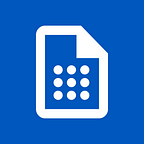Okay, data is the future of education — but where to begin as a teacher?
“Software is eating the world” is a sentence often echoed by technologists everywhere. While it might sound a little alarmist, it is undeniable that software is already an integral part of our lives. It’s part of how we interact with our friends, with our family. It’s how we travel. How we shop. It’s the powerhouse of the fourth industrial revolution. It’s here to stay.
Surprisingly, both the fuel and the product by this unprecedented computational revolution is the same: data — and there is a lot of it. A lot. It’s so much, it’s hard to put it in perspective, but think about this: it is estimated that 90% de data in the world was created in the last two years alone. Along with the data, comes the opportunity to analyse, dissect, interpret it. So much effort is being put into extracting meaning from all this information that we seem to be going through a gold rush of information.
What is data, anyway?
Whenever we browser social media, click on links, shop online, google questions or watch movies, we leave a trail of information behind us. Many companies’ whole business models rely on mining the data we produce daily in order to customize our online experience. In this context, privacy plays an important role, too.
Inside the classroom, on the other hand, there is amazingly rich information that technology already makes easily accessible to educators. Tools exist to digest and automate the analysis of some of that information, which teachers can leverage to guide students much more effectively through a data-driven, tailored learning experience.
Educational data
We wrote previously about the pros and cons of multiple choice tests, but let’s take one of those as an example. On a first take, this kind of assessment, controversial as it might be, is just that: an assessment. It’s an instrument for grading students — grades are impersonally inferred from marks on an answer sheet and entered into students’ reports.
Within the data-driven mindset, educators can flip that idea around: multiple choice tests can be used for inferring knowledge, and the data extracted from the students’ answers can be fed back into the classroom. To make matters concrete, let’s take a look the automatically generated analysis of one multiple choice test from SmartGrade:
On the first half of the screen, student’s grades are aggregated in a histogram. This data representation tells us about the average, minimum and maximum grade, as well as gives us a good idea of the distribution of grades amongst students. In addition to that, educators can compare grades distribution between multiple classes, or even between multiple exams from the same class.
On the bottom half of the screen, we see the percentage of correct answers by question (or item). For instance, only 10% of the students answered item 5 correctly. This information is immediately actionable: educators can revisit that topic with the classroom.
In addition to analysing exams, there is also rich information about individual students. SmartGrade will also automatically generate a dynamic picture of each student, depicting how their performance evolves through time, across multiple exams.
Student analysis is a great tool for identifying students that need extra support. It is also a tool for identifying and empowering well-performing students to provide support.
Where to start as a teacher?
Data analysis doesn’t have to be complicated or time consuming. There are many tools that automate the data collection and provide a digested and actionable analysis of test answers. SmartGrade turns your smartphone into bubble sheet scanner, automatically grades multiple choice tests and automatically generates actionable data analysis for teachers. It is completely free to try and can be set up in only a few seconds.
Happy teaching!
